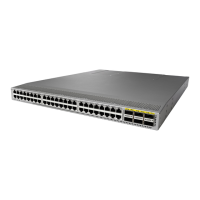Send comments to nexus3k-docfeedback@cisco.com
-SM-180
Cisco Nexus 3000 Series NX-OS System Management Command Reference
OL-29557-04
Chapter System Management Commands
sflow collector-ip
sflow collector-ip
To configure the sFlow analyzer address, use the sflow collector-ip command. To remove the sFlow
analyzer address, use the no form of this command.
sflow collector-ip ip-address vrf-instance
no sflow collector-ip ip-address vrf-instance
Syntax Description
Defaults None
Command Modes Global configuration
Command History
Usage Guidelines You must use the vrf-management option if the sFlow data collector is on the network connected to the
management port
You must use the vrf-default option if the sFlow data collector is on the network connected to the front
panel ports.
This command does not require a license.
Examples This example shows how to configure the IPv4 address of the sFlow data collector that is connected to
the management port.
switch# configure terminal
switch(config)# sflow collector-ip 192.0.2.5 vrf-management
switch(config)# copy running-config startup-config
Related Commands
ip-address IPv4 address.
vrf-instance Specifies the virtual router context (VRF) instance. The VRF can be one
of the following:
• vrf-name—VRF name. The name can be any case-sensitive,
alphanumeric string up to 32 characters.
• vrf-default—Specifies the default VRF.
• vrf-management—Specifies the management VRF.
Release Modification
5.0(3)U4(1) This command was introduced.
Command Description
feature sflow Enables sFlow.
show sflow Displays sFlow information.

